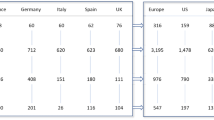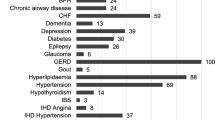Abstract
Background: Parkinson’s disease (PD) is a common neurodegenerative disorder in the elderly that may lead to both motor and non-motor symptoms with consequent severe impairment of quality of life. PD also represents a substantial economic burden on society because of the patient’s decreased ability to work, increased need for care and need for costly treatment. Evaluation of quality-adjusted life-years (QALYs) is an important tool in cost-effectiveness analyses. To date, however, few data have become available about the utility gains or losses associated with the disease and its management.
Objectives: To evaluate the changes in health state values in patients with newly diagnosed PD during their first year of drug treatment, and to calculate the gain in QALYs and the incremental cost-effectiveness ratio (ICER) for this patient group.
Methods: In this prospective, population-based, cohort study, 199 patients with incident PD and 172 controls were followed over 1 year. Clinical data, drug use and utility scores obtained from the Short Form 6D (SF-6D) health state questionnaire were documented.
Results: Patients with PD had lower SF-6D utility scores than controls at baseline. Patients started on antiparkinsonian drugs had an improvement in mean utility scores of 0.039 from 0.667 to 0.706 (p<0.05). The ICER was h45 259 (2007 values) per QALY, of which two-thirds consisted of the costs of drugs and one-third represented the costs of clinical consultations.
Conclusion: Drug treatment in patients with early-stage PD increases health state values, but the ICER is high. Further investigations will be necessary to capture the full consequences of treatment of PD and to evaluate the efficacy of disease management in this setting.



Similar content being viewed by others
References
Torrance GW. Measurement of health state utilities for economic appraisal. J Health Econ 1986 Mar; 5(1): 1–30
Tandberg E, Larsen JP, Nessler EG, et al. The epidemiology of Parkinson’s disease in the county of Rogaland, Norway. Mov Disord 1995 Sep; 10(5): 541–9
Schrag A, Ben-Shlomo Y, Quinn NP. Cross sectional prevalence survey of idiopathic Parkinson’s disease and parkinsonism in London. BMJ 2000 Jul 1; 321(7252): 21–2
Alves G, Wentzel-Larsen T, Aarsland D, et al. Progression of motor impairment and disability in Parkinson disease: a population-based study. Neurology 2005 Nov 8; 65(9): 1436–41
Aarsland D, Karlsen K. Neuropsychiatric aspects of Parkinson’s disease. Curr Psychiatry Rep 1999 Oct; 1(1): 61–8
Hagell P, Nordling S, Reimer J, et al. Resource use and costs in a Swedish cohort of patients with Parkinson’s disease. Mov Disord 2002 Nov; 17(6): 1213–20
Vossius C, Nilsen OB, Larsen JP. Parkinson’s disease and nursing home placement: the economic impact of the need for care. Eur J Neurol 2009 Feb; 16(2): 194–200
Hoehn MM, Yahr MD. Parkinsonism: onset, progression and mortality. Neurology 1967 May; 17(5): 427–42
Fahn SER. Unified Parkinson’s Disease Rating Scale. In: Fahn S, Marsden CD, Calne D, et al., editors. Recent developments in Parkinson’s disease. Florham Park (NJ): Macmillan Healthcare Information, 1987: 153–63
Dowding CH, Shenton CL, Salek SS. A review of the health-related quality of life and economic impact of Parkinson’s disease. Drugs Aging 2006; 23(9): 693–721
Alves G, Muller B, Herlofson K, et al. Incidence of Parkinson’s disease in Norway: the Norwegian ParkWest study. J Neurol Neurosurg Psychiatry 2009 Aug; 80(8): 851–7
Schwab RS, England Jr AC, editors. Projection technique for evaluating surgery in Parkinson’s disease. Edinburgh: Livingstone, 1969
Brazier J, Roberts J, Deverill M. The estimation of a preference-based measure of health from the SF-36. J Health Econ 2002 Mar; 21(2): 271–92
Brazier J, Usherwood T, Harper R, et al. Deriving a preference-based single index from the UK SF-36 Health Survey. J Clin Epidemiol 1998 Nov; 51(11): 1115–28
Parkin SG, Gregory RP, Scott R, et al. Unilateral and bilateral pallidotomy for idiopathic Parkinson’s disease: a case series of 115 patients. Mov Disord 2002 Jul; 17(4): 682–92
Walters SJ, Brazier JE. What is the relationship between the minimally important difference and health state utility values? The case of the SF-6D. Health Qual Life Outcomes 2003; 1: 4
Noyes K, Dick AW, Holloway RG. Pramipexole and levodopa in early Parkinson’s disease: dynamic changes in cost effectiveness. Pharmacoeconomics 2005; 23(12): 1257–70
Siderowf A, Ravina B, Glick HA. Preference-based quality-of-life in patients with Parkinson’s disease. Neurology 2002 Jul 9; 59(1): 103–8
Brazier J, Roberts J, Tsuchiya A, et al. A comparison of the EQ-5D and SF-6D across seven patient groups. Health Econ 2004 Sep; 13(9): 873–84
Vossius C, Gjerstad M, Baas H, et al. Drug costs for patients with Parkinson’s disease in two different European countries. Acta Neurol Scand 2006 Apr; 113(4): 228–32
LePen C, Wait S, Moutard-Martin F, et al. Cost of illness and disease severity in a cohort of French patients with Parkinson’s disease. Pharmacoeconomics 1999 Jul; 16(1): 59–69
Martinez-Martin P, Arroyo S, Rojo-Abuin JM, et al. Burden, perceived health status, and mood among caregivers of Parkinson’s disease patients. Mov Disord 2008 Sep 15; 23(12): 1673–80
Acknowledgements
The clinical data applied in this study were collected by the Norwegian ParkWest Study Group. We thank John Brazier at Health Economics and Decision Science, University of Sheffield, UK, for his kind advice in generating the utility scores and in executing the study. We thank the Lars Kristian Sundseths Legat for its financial support. The authors have no conflicts of interest that are directly relevant to the content of this study.
Author information
Authors and Affiliations
Corresponding author
Rights and permissions
About this article
Cite this article
Vossius, C., Nilsen, O.B. & Larsen, J.P. Health State Values during the First Year of Drug Treatment in Early-Stage Parkinson’s Disease. Drugs Aging 26, 973–980 (2009). https://doi.org/10.2165/11318750-000000000-00000
Published:
Issue Date:
DOI: https://doi.org/10.2165/11318750-000000000-00000




